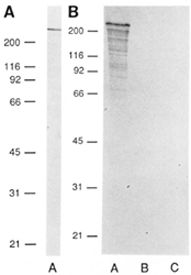Anti-Adenylate Cyclase Toxin [9D4] Antibody
This IgG2a mouse antibody was generated against Bordetella pertussis Adenylate Cyclase toxin and recognizes an epitope in the glycine and aspartate-rich nonapeptide repeat region (amino acids 1156-1489) of B. pertussis and other repeats-in-toxin (RTX) family bacteria toxins.
Highlights:
- Reacts with adenylate cyclase
- Suitable for Western Blot and Immunoprecipitation applications
Recombinant versions available from our sister company, Absolute Antibody:
- Manufactured using Absolute Antibody’s Recombinant Platform with variable regions (i.e., specificity) from the hybridoma 9D4.
Adenylate Cyclase Toxin (ACT or Cya A) is one of several virulence factors produced by the bacterium Bordetella pertussis. This toxin invades eukaryotic cells and catalyzes the conversion of ATP into cyclic AMP (cAMP). This leads to inhibition of host cell immune function and macrophage death by apoptosis. The Adenylate Cyclase protein is composed of a catalytic domain (amino acids 1 to 400), a hydrophobic region (amino acids 500 to 700), a glycine/aspartate-rich repeat unit (amino acids 1000 to 1600), and the C-terminal domain (amino acids 1600-1706).
From the laboratory of Erik L. Hewlett, MD, University of Virginia.
This IgG2a mouse antibody was generated against Bordetella pertussis Adenylate Cyclase toxin and recognizes an epitope in the glycine and aspartate-rich nonapeptide repeat region (amino acids 1156-1489) of B. pertussis and other repeats-in-toxin (RTX) family bacteria toxins.
Highlights:
- Reacts with adenylate cyclase
- Suitable for Western Blot and Immunoprecipitation applications
Recombinant versions available from our sister company, Absolute Antibody:
- Manufactured using Absolute Antibody’s Recombinant Platform with variable regions (i.e., specificity) from the hybridoma 9D4.
Adenylate Cyclase Toxin (ACT or Cya A) is one of several virulence factors produced by the bacterium Bordetella pertussis. This toxin invades eukaryotic cells and catalyzes the conversion of ATP into cyclic AMP (cAMP). This leads to inhibition of host cell immune function and macrophage death by apoptosis. The Adenylate Cyclase protein is composed of a catalytic domain (amino acids 1 to 400), a hydrophobic region (amino acids 500 to 700), a glycine/aspartate-rich repeat unit (amino acids 1000 to 1600), and the C-terminal domain (amino acids 1600-1706).
From the laboratory of Erik L. Hewlett, MD, University of Virginia.
| Catalog Number | Product | DataSheet | Size | AVAILABILITY | Price | Qty |
|---|
| Product Type: | Antibody |
| Name: | Adenylate Cyclase Toxin [9D4] Antibody |
| Antigen: | Adenylate Cyclase Toxin (ACT, Cya A) |
| Accession ID: | J7QLC0 |
| Isotype: |
EG8002: IgG2a Recombinant versions: see product name |
| Clonality: | Monoclonal |
| Clone Name: | 9D4 |
| Reactivity: | Recognizes an epitope in the glycine and aspartate-rich nonapeptide repeat region (amino acids 1156-1489) of B. pertussis and other repeats-in-toxin (RTX) family bacteria toxins |
| Immunogen: | generated against Bordetella pertussis Adenylate Cyclase toxin |
| Species Immunized: | Mouse |
| Purification Method: | Protein G |
| Buffer: |
EG8002: 0.1M Sodium Phosphate, pH 7.4, 0.15M NaCl, 0.05% (w/v) Sodium Azide Recombinant versions: PBS with 0.02% Proclin 300 |
| Tested Applications: | WB, IP |
| Concentration: | 1mg/mL |
| Comments: | Recommended for detection of Cya A of B. pertussis origin by Western Blotting (starting dilution 1:200, dilution range 1:100 to 1:1000) and immunoprecipitation [12 μg per 100 to 500 µg of total protein (1 ml of cell lysate)] |
| Storage: | -20C |
| Shipped: | Cold packs |
Proposed epitope map of 9D4 mAb against AC toxin

The linear sequence of AC toxin is shown along with its four major domains. Solid bars indicate the proposed epitope of the 9D4 mAb.
Adapted from: Lee SJ, Gray MC, Guo L, Sebo P, Hewlet EL. Epitope Mapping of Monoclonal Antibodies against Bordetella pertussis Adenylate Cyclase Toxin. Infect Immun. 67(5): 2090-5 (1999).
Monoclonal antibody that immunoprecipitates AC enzyme activity recognize a 216-kDaprotein by Western blot.

(A) Sucrose gradient pool (210 pg/ml) was separated by 12.5% SDS-PAGE, transferred onto a PVDF membrane, and incubated with 9D4 monoclonal antibody. (B) Urea extracts (25 pg each) of BP338, wild type strain (lower A), and two Tn5 mutants, BP348 (lane B) and RP347 (laneC), both lacking AC, were fractionated by 12.5% SDS-PAGE, transferred to PVDF, and incubated with monoclonal antibody 9D4.
Adapted from: Hewlett EL, Gordom VM, McCaffery JD, Sutherland WM, Gray MC. Adenylate Cyclase Toxin from Bordetella pertussis. J Biol Chem. 264(32): 19379-84 (1989).
- Lee SJ, Gray MC, Guo L, Sebo P, Hewlet EL. Epitope Mapping of Monoclonal Antibodies against Bordetella pertussis Adenylate Cyclase Toxin. Infect Immun. 67(5): 2090-5 (1999).
- Hewlett EL, Gordom VM, McCaffery JD, Sutherland WM, Gray MC. Adenylate Cyclase Toxin from Bordetella pertussis. J Biol Chem. 264(32): 19379-84 (1989).
If you publish research with this product, please let us know so we can cite your paper.

![Recombinant Anti-Adenylate Cyclase Toxin [9D4], Mouse, IgG2a Product](https://www.kerafast.com/MediaStorage/Product/Images/Medium/5700_20210728085918360.jpg)
